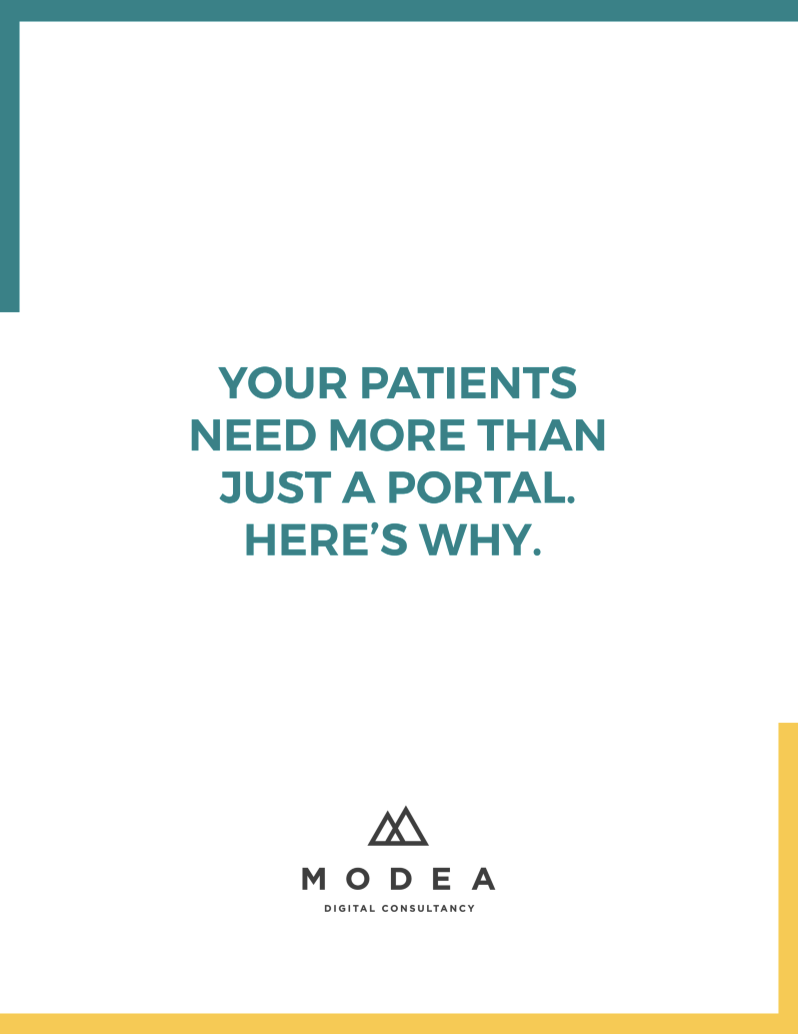
Health systems are under pressure to modernize their digital foundations. Industry uncertainty, revenue challenges, and the rapid rise of AI are pushing leaders to take a hard look at their technology stacks, especially their web platforms. Many are weighing replatforming to a different CMS, moving to a full DXP, and exploring composable solutions that offer flexibility without overcommitment.
Sitecore, and particularly its new SaaS XM Cloud solution, is gaining traction among healthcare organizations navigating these decisions. At Modea, we’ve worked extensively with Sitecore in partnership with healthcare organizations and have seen how its evolution is shaping digital transformation strategies. Our Sitecore-certified developers and strategy consultants have provided firsthand insights into how Sitecore is evolving, and why it is proving to be a strong enterprise platform choice for health systems.
The sections below explore the capabilities that we believe make Sitecore well-suited for today’s digital transformation challenges.
Structured, Scalable Architecture
One of Sitecore’s core strengths is the way it separates components from content. This structure gives marketing teams the freedom to build and update pages quickly, without leaning on developers for every change. At the same time, IT teams keep a framework that is secure, scalable, and easy to maintain. The result is a platform that balances flexibility with governance, so marketing leaders can respond to patient and consumer needs while still protecting brand consistency and compliance.
Without that structure, digital platforms often drift into fragmentation, with campaigns slowed down by technical bottlenecks and costly inefficiencies. Sitecore helps prevent this by enforcing consistency and keeping projects organized, which makes scaling far easier as needs grow. Instead of untangling platform issues, leaders can stay focused on strategies that drive patient engagement and growth.
In our work, we often see how important this structured foundation is. When platforms provide clear guardrails, teams are able to spend less time resolving technical hurdles and more time creating digital experiences that matter to patients and providers.
Architecture is just the foundation, though. Healthcare organizations also need flexibility in how content is delivered. This is where Sitecore’s balanced approach to headless architecture adds another layer of value.
Balanced Headless Capabilities
Sitecore offers headless functionality without sacrificing enterprise infrastructure. In a headless model, the CMS separates the “back end” (where content is created and stored) from the “front end” (where it is displayed). This enables marketing and development teams to deliver the same content in its appropriate format across multiple channels, including websites, apps, and patient portals, without duplicating effort. As a result, the technical model aligns closely with rising consumer expectations for digital consistency.
Patients and consumers expect a unified digital experience at every touchpoint, whether they are visiting a website, using a mobile app, or logging into a patient portal. Meeting that expectation requires technology that can deliver content consistently across channels, and headless delivery makes this possible by giving marketing teams the flexibility to publish consistently across all channels while maintaining governance, security, and scalability.
As one of Modea’s Sitecore-certified engineers noted:
“Sitecore’s value is in its maturity combined with its ability to adopt modern trends like headless. In the last few projects we’ve worked on, headless was a must-have for development teams from the start.”
Sitecore’s combination of stability and flexibility, in our experience, makes it well-suited for organizations that need modern content delivery methods supported by proven enterprise reliability. That balance is also reflected in Sitecore’s Pages functionality, which gives teams a visual, drag-and-drop authoring experience while still respecting developer-defined rules. This bridges the gap between marketing teams who want independence and development teams who need structure.
As another Modea engineer explained:
“Because of how Sitecore separates content from components, [content] editors get a dynamic building experience without needing technical knowledge.”
This approach translates into faster content production without compromising brand or technical standards. While headless empowers marketing and content teams, Sitecore also addresses the needs of developers, supporting scalability and clean code management over time.
Efficiency for Development Teams
Replatforming is a costly and resource-intensive decision, so choosing a scalable and flexible solution that keeps the codebase clean helps reduce rework and ensures the platform can support growth for years to come. Sitecore includes features that support both scalability and flexibility.
First, its inheritance system allows templates, layouts, and components to be defined once and reused across multiple pages or experiences. This approach enforces consistency, reduces repetitive code, and makes onboarding easier for new developers. Recent Sitecore updates, such as a component creation wizard and automated content tree organization, further cut down on manual steps in large implementations.
These kinds of efficiencies are often undervalued at the planning stage but become important over the life of a platform. Clean inheritance and automation do more than save developer hours in the short term; they reduce technical debt, lower long-term maintenance costs, and improve the ability of teams to adapt as strategies and priorities evolve. In complex healthcare environments, where digital transformation often spans years, this distinction is critical — platforms that scale predictably sustain momentum, while those that accumulate inefficiencies quickly stall.
Even with efficient development practices, many health systems still need more than one platform to cover their full digital needs. A composable technology stack offers a way to integrate specialized tools without losing cohesion.
A Composable Tech Stack
Composability is gaining momentum as enterprises rethink their digital foundations. Instead of relying on a single, all-in-one platform, a composable stack lets organizations assemble best-in-class tools for different functions and connect them into a unified system.
This approach solves a common challenge: it is rare to find a single vendor that can meet every marketing and patient engagement need. A composable strategy gives marketing leaders the flexibility to adopt specialized tools that align with their goals, scale with organizational growth, and adapt as patient expectations evolve.
Through our client work, we’ve seen how this flexibility creates measurable impact. Many health systems use Sitecore as the foundation of a composable stack, leveraging its strengths in content management while integrating tools for personalization, analytics, or campaign management. This modular approach helps reduce costs, streamline processes, and ensure teams are only investing in the tools they actively use.
As organizations embrace more flexible stacks, many are also reconsidering the foundations of their platforms. Sitecore’s XM Cloud reflects this shift by combining composability with a modern SaaS model.
Real-World Modernization with Sitecore XM Cloud
Our partnerships with health systems show that modernization is no longer a buzzword but a strategic necessity to manage costs, strengthen security, and prepare for the significant changes AI is bringing to the industry. The challenge is not whether to modernize, but how to do so without being weighed down by unnecessary complexity. Sitecore XM Cloud addresses this challenge directly, offering a clear and pragmatic approach.
We’ve found that XM Cloud simplifies both implementation and ongoing management, which is a significant win for overtaxed IT and marketing teams. The guided setup, automation features, and improved interface mean new teams can get up to speed faster, while enterprise-grade capabilities ensure scalability across large organizations. XM Cloud, in our opinion, strikes the right balance between simplicity and strength.
Expanding Marketplace
Sitecore’s evolving ecosystem is a clear signal of their commitment to a more agile, composable future. Extending Sitecore once required extensive custom code and often came with significant upgrade risks. The new marketplace changes this by offering pre-built integrations and extensions, making it easier to adopt new functionality without added complexity. From our perspective, this shift is especially important for healthcare organizations that need to move quickly while maintaining stability. The caveat, of course, is that these extensions still need careful evaluation to avoid unintended complexity – but the potential for rapid integration is undeniable.
With integrations becoming more accessible, the focus naturally shifts back to content itself. This is where Sitecore’s Digital Asset Management (DAM) capabilities prove essential. As content libraries grow rapidly, asset management can quickly become a bottleneck, hindering efficiency and compliance. Sitecore’s DAM provides the necessary framework: version control, shared access, and structured workflows that streamline production and reduce duplication. For healthcare teams managing vast volumes of patient- and provider-facing assets, efficiency and compliance are paramount, and a strong DAM is non-negotiable.
Conclusion
Our experience shows that the most successful digital transformations in healthcare are not sweeping overhauls but thoughtful, phased implementations. The true challenge isn’t whether to modernize, but how to manage that change in a way that minimizes disruption for patients, providers, and internal teams. A phased adoption model, where you start with core content management and gradually expand into advanced capabilities like personalization or DAM when the organization is ready, provides a clear and sustainable path forward.

